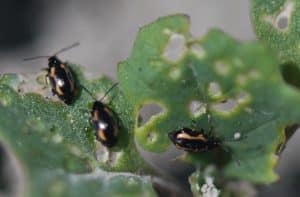Striped flea beetles emerge one to four weeks before the crucifer flea beetles, and they are often found feeding on early-emerging canola volunteers. See more on emergence timing an life cycle in the Overview section here. This does not necessarily mean another bad year for flea beetles. Note that rapid emergence of a canola crop generally favours the seed-treated crop over the flea beetles.
From a crop staging and management perspective, the question is whether first-emerging crops will attract flea beetles from a wider area. They may. The first crops to emerge present an irresistible pull on the beetles in nearby fields. Populations of flea beetles may congregate on these early crops, and these crops may suffer more damage than crops emerging in a landscape with more food options.
On flea beetle travel, James Tansey, provincial specialist in insect pest management with Saskatchewan Ministry of Agriculture, says: “Although it is thought that invasion of fields occurs primarily by hopping or walking, they commonly fly and have been trapped at heights of 7 metres. Striped flea beetles fly primarily in April and May. Crucifer flea beetles start flying a little later but will sustain this activity longer. Crucifer flea beetle flies higher and more frequently; their flight is stimulated by daytime highs over 14°C. Both species fly until June. The distances these beetles fly is not well documented, but anecdotal accounts of flights well over 100 metres exist.”


